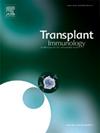在健康同种异体小鼠模型中,尽管供体细胞可进入胃肠道和肺组织,但在羊膜内或血管内细胞递送后,供体细胞无法植入
IF 1.4
4区 医学
Q4 IMMUNOLOGY
引用次数: 0
摘要
子宫内造血细胞移植(IUHCT)利用胎儿的耐受性免疫发育来促进供体的植入。在子宫内和出生后的造血细胞移植模型中都描述了非造血供体来源的细胞。然而,尽管有报道称有上皮细胞通路,但IUHCT后的长期植入尚未得到很好的研究。我们使用羊膜内(IA)或血管内(IV) IUHCT来评估肺和胃肠道(GI)内的路径和植入。注射IA后24 h羊水供体细胞存活率较高(平均89.1%)。在24和72小时,供体细胞出现在胃肠道和肺组织的管腔内以及肝脏的实质中,这表明在注射IA后,供体细胞可以有效地到达上皮表面和血液目标。然而,在IA递送后,在外周血中未观察到长期植入,并且在包括肺、肠或肝在内的任何靶组织中均未发现供体来源细胞的证据。静脉注射后,末采时外周血嵌合率平均为23.86% (SEM 12.44;范围0.00 - -98.90)。静脉给药后,在肠、肝和肺中发现了供体来源的细胞,但在上皮中没有发现,表明这些细胞是循环细胞或组织驻留的白细胞。尽管供体细胞可以定向到多个胎儿部位,但IA注射对于在造血生态位、器官实质或上皮表面长期植入是一种极其低效的方法。相比之下,尽管IV IUHCT能够持续产生造血植入,但未观察到上皮植入,这表明IV IUHCT在上皮疾病中的作用有限。本文章由计算机程序翻译,如有差异,请以英文原文为准。
Despite routing to GI and pulmonary tissues, donor cells fail to engraft after intra-amniotic or intravascular cell delivery in a healthy allogeneic mouse model
In utero hematopoietic cell transplantation (IUHCT) exploits tolerogenic fetal immunologic development to facilitate engraftment of donor. Non-hematopoietic donor-derived cells have been described in both in-utero and post-natal models of hematopoietic cell transplantation. However, while epithelial routing has been reported, long-term engraftment following IUHCT has not been well studied. We utilized intra-amniotic (IA) or intravascular (IV) IUHCT to evaluate routing and engraftment within the pulmonary and gastrointestinal (GI) tract. High donor-cell viability is observed in the amniotic fluid 24 h after IA injection (mean 89.1 %). At 24 and 72 h, donor cells were present within the lumens of GI and pulmonary tissues and in the parenchyma of the liver, suggesting that donor cells route effectively to epithelial surfaces and hematogenous targets following IA injection. However, following IA delivery, long-term engraftment was not observed in peripheral blood, and there was no evidence of donor-derived cells in any target tissue including lung, bowel, or liver. Following IV injection, mean peripheral blood chimerism at terminal harvest was 23.86 % (SEM 12.44; Range 0.00–98.90). Following IV delivery, donor-derived cells were noted in the bowel, liver, and lung but not in the epithelium, suggesting these cells are circulating or tissue-resident leukocytes. Despite the routing of donor cells to multiple fetal sites, the IA injection was an extremely inefficient method for long-term engraftment in the hematopoietic niche, in organ parenchyma, or on epithelial surfaces. In contrast, despite IV IUHCT being able to consistently produce hematopoietic engraftment, epithelial engraftment was not observed, suggesting a limited role for IV IHUCT in epithelial disorders.
求助全文
通过发布文献求助,成功后即可免费获取论文全文。
去求助
来源期刊

Transplant immunology
医学-免疫学
CiteScore
2.10
自引率
13.30%
发文量
198
审稿时长
48 days
期刊介绍:
Transplant Immunology will publish up-to-date information on all aspects of the broad field it encompasses. The journal will be directed at (basic) scientists, tissue typers, transplant physicians and surgeons, and research and data on all immunological aspects of organ-, tissue- and (haematopoietic) stem cell transplantation are of potential interest to the readers of Transplant Immunology. Original papers, Review articles and Hypotheses will be considered for publication and submitted manuscripts will be rapidly peer-reviewed and published. They will be judged on the basis of scientific merit, originality, timeliness and quality.
 求助内容:
求助内容: 应助结果提醒方式:
应助结果提醒方式:


